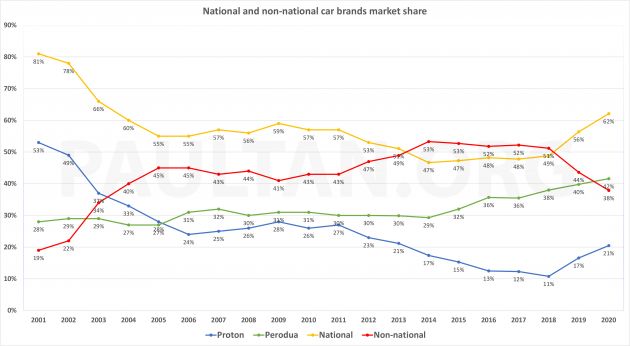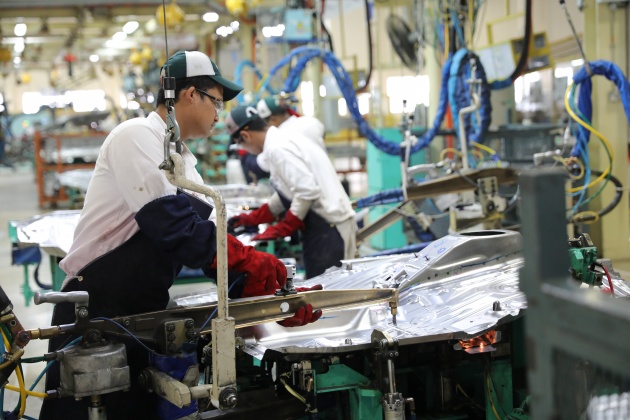We’ve had some time to look at the 2020 Malaysian auto sales figures now, and we spot a trend within the total industry volume (TIV). All things considered – including Covid-19 and the various phases of movement control to suppress it – market leader Perodua and runner-up Proton both had a good year of sales, aided by the government’s sales tax exemption that started in June.
Perodua sold 220,163 units in 2020. While some way off 2019’s record 240,341 units (original 2020 target was 240k), the final tally easily met the revised target of 210,000 units P2 announced in August. Meanwhile, Proton is settling comfortably into the runner-up seat now after regaining the spot in 2019 – one of the few brands that saw sales go up last year, the carmaker did 108,524 units in 2020, an 8.3% improvement.
In terms of market share, Perodua extended its slice of the pie from 39.8% to 41.6%, while Proton’s sales jump earned it a fifth of the market – 20.5% from 2019’s 16.6%. Combined, the national carmakers hold a commanding 62.1% of the Malaysian auto market, the highest 2003. Last year, six out of every 10 cars sold was a Perodua or Proton, but it wasn’t very long ago that the story was so different.
Rise of the imports
When we were covering the 2014 TIV, the breaking news back then was the non-national brands overtaking Proton-Perodua for the first time ever. Buoyed by an on-form Honda (2014 sales were up 50% year-on-year), foreign brands garnered 53% market share to P1-P2’s 47% (rounded up).
If you look at the trend, the non-national brands taking the lead in 2014 was a matter of time, as they started gaining serious ground from 2011. The national brands’ steady decline was entirely down to the poor performance of Proton. 2011 was the final year that P1 has market share in the high 20s; from there it slid all the way down to just 11% in 2018. At the turn of the millennium, Proton alone controlled over half of Malaysia’s car market, so it’s a spectacular fall.
Perodua’s share of the pie hovered consistently around the 30% mark for a decade beginning 2006. While the market leader was holding its own, the combined national share’s decline still caused concern for P2. Then president/CEO Datuk Aminar Rashid Salleh attributed the shift to market liberalisation.
It was a time when the big three Japanese marques were aggressive in the B-segment, introducing new models with entry prices that encroached into the top end of traditional Proton/Perodua territory. The N17 Nissan Almera in 2012, the “keli” Toyota Vios in 2013 and Honda’s super successful fourth-gen City (and its Jazz sister) in 2014 were all hot sellers. In contrast, the Protons of that period – the Preve C-segment sedan, its Suprima S hatch sister, and the Myvi-fighting Iriz – weren’t sales successes.
In 2016, Perodua chairman Tan Sri Asmat Kamaludin said that a national brand market share of below 50% is not healthy for the local automotive industry. It was a rare strong public statement from a P2 boss.
“While we understand the government’s intention to liberalise the automotive industry in the near term, we believe that the country’s automotive eco-system, consisting of local vendors and dealers, as well as original equipment manufacturers like Perodua, has yet to reach a point where we can fairly compete with other established global brands,” he said.
“This is because we have yet to reach the level of maturity, in terms of economies of scale, cost competitiveness and even quality, with other established global brands. If the percentage continues to slide to below 45% then many of the local dealers and vendors may have to cease operations and this will have a negative impact on the economy as a whole,” Asmat added, stopping short of calling for protection.
Proton, rising from the ashes
Fortunately, the national share never dipped below 45%. Since that statement of concern, Perodua single-handedly took on the imports as Proton continued its slide. If you look at the graph, the turning point for Proton was in 2018, when it reached its nadir of just 11% market share. But the real game changer was the entry of Geely in mid 2017, where the Chinese carmaker took up 49.9% stake in Proton, and took over the steering wheel.
You don’t invest in a company and not push it hard to succeed, and the Geely-fuelled revival was clear for all to see in 2019, when Proton launched improved facelifts of the Persona, Iriz, Exora and Saga. All in one year, which is unprecedented. What more, 2019 was the first full year of sales for the Proton X70, the brand’s first Geely-based product that was launched in December 2018. Internally, they call the four pre-Geely models PIES, and Proton’s share of the pie took a sharp rebound, to 17% in 2019 and 21% in 2020.
Looking at the graph, it’s clear that the national brands’ uptick from 2018 mirrors that of Proton’s revival. Perodua? They’re never the loudest, those efficient folks from Rawang, but they’ve been posting year after year of record sales.
2018 was the first full year of sales for the third-generation Myvi, and P2’s small range (applicable to both vehicle size as well as the number of models) expanded upwards with the Aruz seven-seater in 2019. Those two models, plus the facelifted Axia, propelled Perodua to record 240k sales in 2019. So, it’s clear that Proton’s rise is not at the expense of its counterpart from Rawang.
Instead, both the market leader and Proton are chipping away at the gains the import brands have built in recent times. Let’s take Honda for instance. With a late surge in 2020, it pipped Toyota to be the best-selling non-national brand for the sixth consecutive year, and third overall.
However, the 60,468 Hondas that were sold last year is 29% lower than in 2019 (85,418), which was also a big drop from 2018’s 102,282 units. The all-time record for Honda Malaysia was in 2017, where it sold 109,511 units to breach the 100k per annum mark for the first time. Unless a miracle happens, that will forever be the brand’s high point, much like Arsenal’s Invincibles or Leicester City’s miracle title. Ditto the overall No.2 spot, which Honda somehow managed to occupy for three years (2016-2018).
What does this trend mean for Malaysia’s auto industry? As pointed out by Perodua’s chairman, the rise of national brands will benefit the automotive ecosystem, consisting of local vendors and dealers. P1 and P2 share many local parts suppliers, and higher volumes would be a win-win for all. This is on top of the higher localisation rate of national brand cars.
However, the overall pie isn’t getting larger, as Malaysia is a fairly saturated car market. The TIV for 2020 was close to 530k units, and while the Malaysian Automotive Association (MAA) is forecasting 8% TIV growth this year (to 570k), growth is projected to moderate to 3.0-3.2% from 2023 to 2025.
The new normal?
If the pie isn’t expanding much, the rise of the national brands would mean that the non-nationals will have to get used to a smaller shared portion.
Honda, for instance, is not likely to be a 100k per annum company again, and will have to scale its business here accordingly. CKD operations require a certain volume to be sustainable, and if the sums don’t add up for local assembly, they may just avoid the hassle altogether and import from sister factories in ASEAN. Toyota has already done that – the Camry and Corolla sedans used to be locally assembled, but are now CBU imports from Thailand.
Needless to say, with less CKD projects, the need for local parts and staff would also decline. For consumers, carmakers going the CBU route would translate to higher prices, and/or less equipment, depending on the price strategy for the model.
Personally, I find the Toyota C-HR to be the best illustration – it has looks, X-factor and even driver appeal on its side, but the price gap/value between the CBU Thailand C-HR and the Melaka-assembled Honda HR-V was too big to ignore for most SUV punters. Ultimately, this would mean less choice for the carbuyer. However, this only applies to the mass market non-nationals; the premium players are used to small scale assembly.
Expect this national vs non-national gap to further widen in 2021, as the long-awaited Perodua D55L SUV is set to debut this year. Proton has said that it is capable of launching one new product every year, and there are rumours of either a C-segment sedan, MPV or big SUV joining the range this year. Even if a new model doesn’t materialise, this will be the first full year of sales for the hyped X50.
The post National brands have 62% share of Malaysian market, highest since 2003 – Proton up, not at P2’s expense appeared first on Paul Tan's Automotive News.













0 Comments